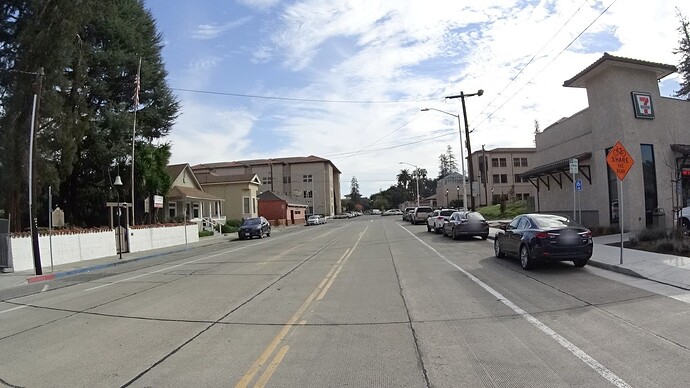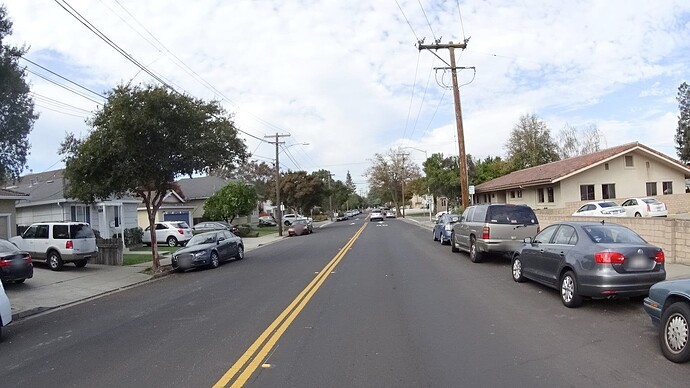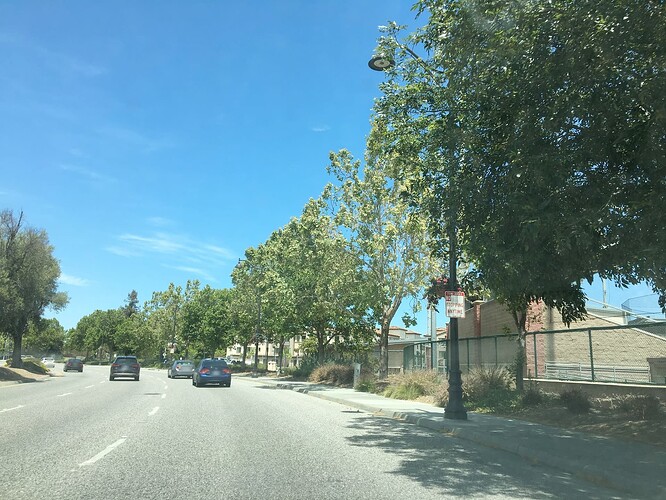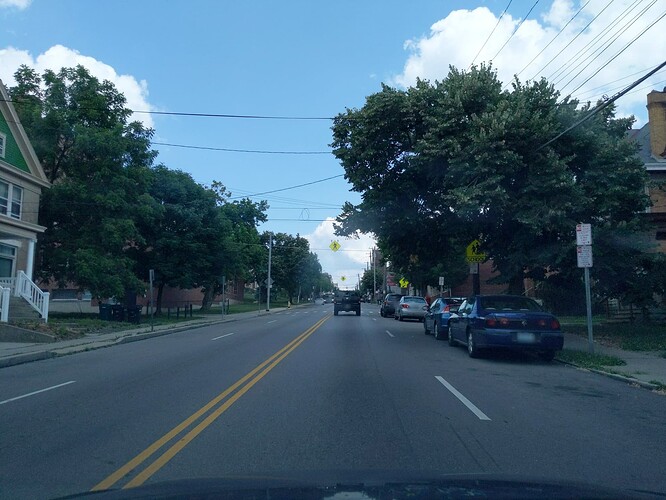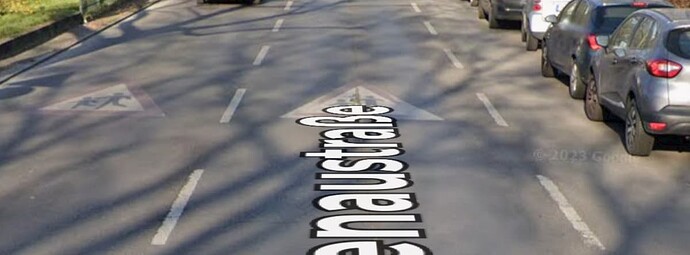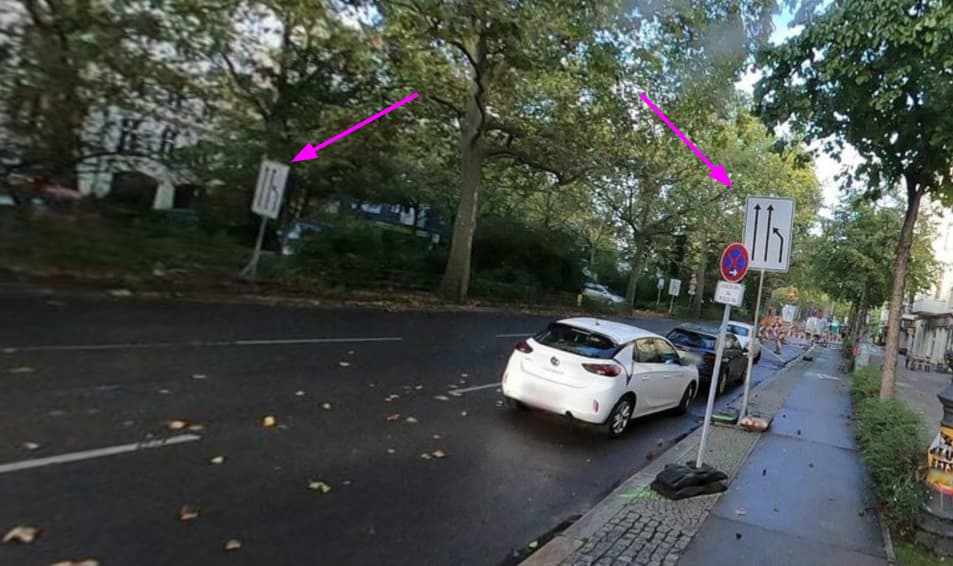So why would you tag the street in the first example with lanes=3 when in that picture the rightmost lane is clearly a parking lane too (see the absence of the warning sign)?
In my opinion, it’s not a parking lane, it’s a traffic lane, where people are parking on. If there were no people parking, you would drive there. A parking lane, on the other hand, is a lane dedicated and marked for parking. You wouldn’t be allowed to drive there, even if there were no parked cars. There are no such markings in the first picture.
In the picture you posted, there are marked parking spaces. If there were no parked cars, you wouldn’t be driving in 3 lanes next to each, but that might be different in different legislations. If you were not allowed to drive there if there were no parked cars, then I would call this a single lane one way street with a dedicated parking lane left and right.
That sounds reasonable, but I’m not sure how to reconcile this with your observations in the other thread. These examples would currently be both parking=lane as I understand it, but it sounds like you’d prefer street_side or shoulder for one of them?
Here are some representative examples that come to mind for me:
Santa Clara, California, sets off many of its parking lanes with a solid white line instead of marking individual spaces. We know The Alameda has a parking lane rather than a shoulder because the signs allow parking. Parking normally isn’t allowed on shoulders unless the sign explicitly refers to a shoulder. Also, the Share the Road sign says cyclists use the traffic lane rather than the parking lane to avoid getting doored.
On some residential streets, such as Alviso Street, the parking lane has no markings and potentially no signs if parking is unrestricted. We only know there’s a parking lane because the traffic lane would otherwise be abnormally wide.
Of course, width is not the only factor. El Camino Real has lots of room but stopping is prohibited. A never-used, unmarked parking lane is kind of pointless, so I suspect whoever gets around to mapping street parking here would simply tag the no-stopping restriction and ignore the extra space.
Cincinnati, Ohio, doesn’t usually mark individual spaces either. Due to space constraints, the rightmost traffic lane of West McMillan Avenue is a traffic lane during rush hour and a parking lane during off hours. This lane is marked by a standard lane divider, but signs allow parking during certain hours.
I count it as a traffic lane. In some other cases around town where I’ve mapped street parking, I made the lane count and parking restrictions conditional, though I haven’t upgraded them to the latest approved syntax yet.
This example is similar to the example in the first post: lanes marked by standard lane dividers are traffic lanes, not parking lanes.
The only difference is that there are no signs restricting stopping or parking in the first post. However, the local authority can put up signs prohibiting parking or restricting it to certain times at any time. This lane can then be used as a traffic lane without any further changes.
In all other cases, new markings would have to be applied or the markings changed to increase the number of traffic lanes.
Please note that German traffic law applies to this example. The road is clearly marked with standard traffic lane dividers (traffic sign no. 340 in the German road traffic regulations). Explicit parking lanes are marked differently.
What kind of warning sign do you mean? In Germany, parking on the edge of the carriageway is always permitted*) in urban areas if it is not restricted by traffic signs. The fact that parking is also permitted in a traffic lane does not (legally) make the traffic lane a parking lane.
*) There are a few legally stipulated prohibitions at junctions, property exits, pedestrian crossings, etc.
I meant these warning sings, the triangles with two people walking in it
As you can see they’re clearly visible on the left and center lane, but on the right there’s no sign, clearly because that’s not intended as a drivable lane, but only as a parking lane.
No, both don’t seem to be the correct solution. I actually have no idea how to distinguish between lane parking on a traffic lane and lane parking on a parking lane.
Over here, real parking lanes are very rare, so it has always been my understanding, that parking=lane means “on the rightmost traffic lane”, and that we use the street’s/carriageway’s/lane’s width to determine, whether parking cars would block the flow of traffic. However, this would mean that we’d have several choices:
- Add the parking lane’s width to the rightmost lane, and let the total lane width decide whether parked cars would block traffic. Doesn’t say anything about parking lane vs traffic lane, though.
- butcher
parking=shoulder(with a meaning of “parking on the carriageway, but next to the traffic lane”), which would also require addingshoulder:<side>=yesto the road. - go the StreetComplete way and use
parking=on_kerb(not my favourite choice, because the cars aren’t parking on the kerb, and it would usually mean that space is taken from the sidewalk, not the carriageway) - make routers with
parking=lanesearch for aparking:lanes=…|designatedand interpret this as a a dedicated traffic lane. Might be overly complicated in countries where parking lanes are very common. - Invent a
parking_lane:<side>=*-tag (surprisingly, already in use 2822 times), and assumeparking=lanealways refers to this parking lane. - Use
parking:<side>=street_sideand add astreet_side:<side>=parking_laneto distinguish between these two. This could have the benefit that routers would usually considerstreet_sideandparking_laneparking the same, and that iterative refinement allows more or less backward-compatible tagging - Come up with a different
parking=*-value, likeparking=dedicated_laneorparking=off_laneto clearly distinguish between these situations. - Go with @aharvey’s suggestion that
parking=lanealways means “on a dedicated parking lane”, and introduceparking=traffic_lanefor parking on the traffic lane.
But these are just some options that come to mind. What never occurred to me, is reducing the number of traffic lanes of a street, because if there are no marked lanes, I don’t tag any lanes:
For me, the above picture would be neither lanes=1, nor lanes=2. I’d just tag lane_markings=no. There is no lane count I can reduce to indicate that parking:<right>=lane means that parked cars are blocking the traffic, so the whole idea of “taking away” a traffic lane to indicate it’s a parking lane, only works if you have tagged lanes. That’s why I said that the approach of reducing the number of traffic lanes would introduce the need to tag lanes=* on unmarked lanes through the backdoor. I’d simply tag the width of the street with 5m.
I’m not trying to redefine parking, but there seems to be a need to clarify
- What are dedicated parking lanes? (which is a completely separate question)
- How should we tag dedicated parking lanes?
- How do we distinguish between parking on a parking lane vs. parking on a traffic lane?
That’s not how it works in Germany, sorry. I’m not even sure the triangle is missing, but its absence doesn’t mean anything, because the symbol on the ground has no legal indication, only the sign on the right. If these cars weren’t parked there, you would be allowed to drive on that lane. On a parking lane, you are ever allowed to drive.
1st example: lanes=2.2 maybe, because 20% of the rightmost lane is usable. ![]()
Ah, you mean this traffic sign.
The sign on the carriageway itself has no legal effect, it only repeats the sign at the beginning of the road. It warns that people (especially children) can enter the carriageway here (in front of the school) between the parked cars - but that does not make the right-hand lane a parking lane.
The fact that this traffic sign is missing: on the one hand, perhaps they were too lazy or too frugal to prohibit parking in order to place the traffic sign on the carriageway, on the other hand: if nobody parks there, then there is no need to repeat the traffic sign on the carriageway. Children can still run into the road, but they won’t suddenly emerge from between parked cars.
Would you still consider the right-hand lane to be a parking lane in this situation?
or in this situation?
Maybe time to write to the road manager responsible for the lane painting of that district explaining the routing and tagging conflicts posed… no hazard=children in that 3rd lane plus parking:fee=yes make it strong intend to recognize it as a full time parking lane.
There’s a vertical sign, but it’s earlier on the same road
Yes to both, since earlier on the same street there’s a parking sign
Vertical sign? I see a sign that says parking costs money here (which by default, it doesn’t in Germany), and shortly after there’s even a bus stop, so the bus has to drive there.
Earlier on the same street, there’s also this sign:
This merges 3 traffic lanes into 2, because of the construction work ahead. Later on, it also merges from 2 lanes into 1.
If you think that every lane where parking is allowed, is considered a parking lane, then Germany would be full of parking lanes, because it’s the default.
The fact that this traffic sign is missing: on the one hand, perhaps they were too lazy or too frugal to prohibit parking in order to place the traffic sign on the carriageway
my guess is there were parked cars when they put the paint ![]()
In my McMillan Avenue example, it’s either a traffic lane or a dedicated parking lane depending on the time of day. It’s never both at the same time. That would be unfathomable in this country where what’s considered tame driving would probably be shocking in other countries. ![]()
If the signs in Germany are only there to restrict parking but don’t restrict driving, then I suppose they don’t negate the presence of a traffic lane, even if the lane tends to be occupied by parked cars. Maybe you could make an exception if you have some other way of knowing that cars can never drive on that lane in practice.
If the example in the original post represents the norm in Germany, then the “Don’t map local legislation” principle would seem to favor lanes=3 without parking=lane. If that’s unsatisfying, then use parking=on_street or parking=traffic_lane if that’s too vague.
I normally don’t bother to either, but to me this would be lanes=1 with parking:right=lane, similar to the Alviso Street example I gave.
It was my understanding that lanes=* normally excludes dedicated parking lanes because it only includes full-width lanes for moving traffic (including turn lanes but excluding bike lanes). Similarly, *:lanes=* also excludes parking lanes, so if there’s a left turn lane, two through lanes, a bike lane, and finally a parking lane, then I would tag turn:lanes=left|through|through.
Then again, what you called an abomination is in fact quite common in the U.S., apart from the red paint.
Does it? I don’t know, the problem is that it’s not documented, how to tag dedicated parking lanes. How would you do that?
It’s not uncommon over here as well, but they are slowly swapping the parking lane and the bike lane, because if the bikes are on the driver’s side of a car, dooring is a real problem. Swapping the location of the two lanes removes the risk, and allows to installed bollards, or some other form of physical barrier, to separate the bikle lane from the rest of the carriageway.
The lane tagging documentation implicitly excludes dedicated parking lanes, but it could be more explicit. For example, this iD screenshot is given as the primary example for how to map lanes=*. Apparently it depicts someplace in Illinois. For clarity, street parking details have been omitted, but one would expect the parking lane to be called out explicitly if it had any bearing on the lane count.
As for *:lanes=*, I suspect the idea of a parking-only right turn lane, for instance, hasn’t really crossed the minds of many who map turn lanes. (Is that a parking lane where the signs say you have to block your wheels?) Sometimes we have to include bike lanes in turn:lanes=*, resulting in an extra parallel value in vehicle:lanes=* and bicycle:lanes=*. If you really need to tag this parking lane as a turn lane, I suppose access:lanes=yes|no would be valid, if counterintuitive. You’d also have to account for this lane in any other *:lanes=* tag, such as change:lanes=*. This would be analogous to how we’d tag a long-term lane closure, but omitting the lane from turn:lanes=* would be much simpler.
The lane tagging documentation implicitly excludes dedicated parking lanes, but it could be more explicit.
More explicit than
the following lanes should be excluded: […] Lanes dedicated and marked for parking
? Not really.
one would expect the parking lane to be called out explicitly if it had any bearing on the lane count.
Only if it’s a separate parking lane, actually. To me, this just looks like the forward lane is wider than the others, and you have your regular “parking on the right side”. I don’t see any (parking) lane markings, other than some marked parking spots. But it’s really hard to say as an outsider.
omitting the lane from
turn:lanes=*would be much simpler
Well yes, but the same goes for any other non-lanes=*-counted lane like bicycle lanes, doesn’t it? ![]() So the question remains: how would you tag a dedicated, marked parking lane?
So the question remains: how would you tag a dedicated, marked parking lane?
To me, this just looks like the forward lane is wider than the others, and you have your regular “parking on the right side”. I don’t see any (parking) lane markings, other than some marked parking spots.
Well, that’s exactly it. The marked parking spots are the parking lane. This is the stereotypical parking lane. If you take away the markings and signs, it might still be a parking lane, if the street is constructed in such a way that cars drive beside parked cars without crossing another lane divider. If you take away even that capacity, then there isn’t a dedicated parking lane.
